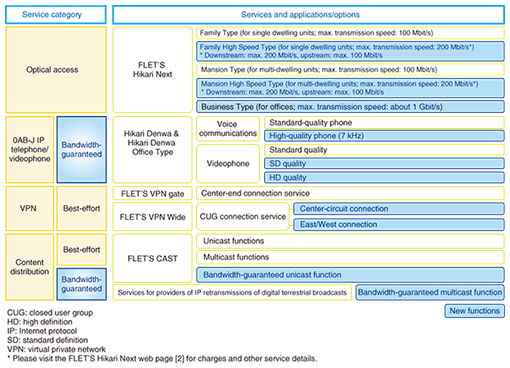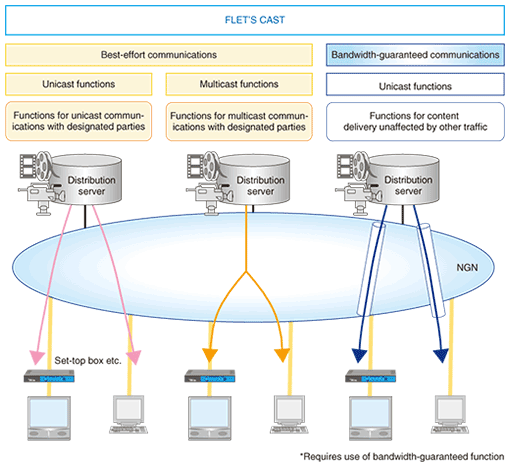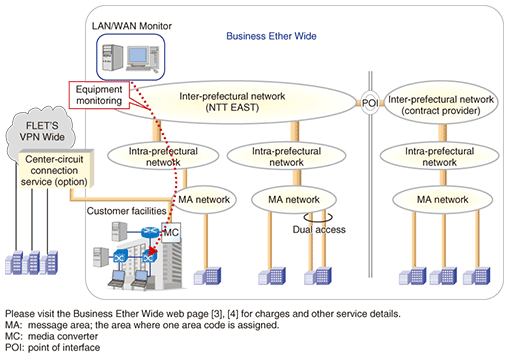 |
|||||||||||||||||||
|
|
|||||||||||||||||||
|
Special Feature: NGN Focus Vol. 7, No. 11, pp. 6–9, Nov. 2009. https://doi.org/10.53829/ntr200911sf1 Commercial Services via the Next Generation Network Provided by NTT EASTAbstractNTT EAST launched FLET’S Hikari Next and Business Ether Wide as services using the Next Generation Network (NGN) in March 2008. This article outlines these key NGN services, together with some other recent NGN services, and the applications and functions that they support.
1. IntroductionNTT EAST launched two major services using the Next Generation Network (NGN) in March 2008 [1]. FLET’S Hikari Next [2] is a next-generation optical broadband access service that supports the use of diverse applications via the NGN in combination with fiber-to-the-home (FTTH) access. Business Ether Wide [3] is a next-generation Ethernet service; it provides an access redundancy menu together with inter-prefectural connections and connections with contract providers. This article outlines these NGN services and the new applications and functions they now provide together with some recent additions to NGN services as well as some important older ones. The features of high-quality applications that can be provided only by an optical NGN are shown divided into the main service categories in Fig. 1, where recently added functions are highlighted in blue. These service categories and the applications provided by them are explained in section 2.2.
2. FLET’S Hikari Next2.1 OutlineFLET’S Hikari Next is a next-generation optical (Hikari*1) broadband service that supports the use of diverse applications, including bandwidth-guaranteed ones, via the NGN in combination with FTTH optical access. It is the underlying technology supporting the following service categories.
2.2 Supported NGN service categories2.2.1 Optical accessOptical access circuits provide an interface with the end user. They incorporate Internet service provider (ISP) connection and IPv6 (Internet protocol version 6) communication functions as standard functions, enabling the use of the bandwidth-guaranteed services in the following categories. 2.2.2 0AB-J IP telephone/videophoneThe Hikari Denwa*2 service category covers Hikari Denwa (for home use [4]) and Hikari Denwa Office Type (for business use). It offers FLET’s Hikari Next subscribers the same optional Hikari Denwa services that have been provided by B FLET’S with additional new services. Hikari Denwa is a Hikari IP service that provides Internet protocol telephone (IP phone) and videophone services that feature session control based on the session initiation protocol (SIP) and a guaranteed top-priority bandwidth. Hikari Denwa therefore not only maintains the quality standard established by IP phones using the 0AB-J numbers, but also provides new services: a clearer, high-quality phone service (7 kHz) and a broadband videophone service that can render natural movement with high resolution (equivalent to standard definition (SD) and high definition (HD) quality).
2.2.3 VPNFLET’S VPN Wide [5] was launched in August 2008 to provide wide area virtual private networks (VPNs) to corporate customers. In addition to closed users group connections, it provides optional connection services such as center-end connections in combination with the Business Ether Wide service described below and connections with the NTT WEST area. FLET’S VPN Wide can also connect with existing FLET’S access services (using asymmetric digital subscriber line (ADSL) rather than FTTH), thereby simplifying the construction of private networks over a wide area. 2.2.4 Content distributionFLET’S CAST, which conforms to technical specifications drawn up by the Internet protocol television (IPTV) Forum (content delivery network (CDN) scope-of-services approach specifications), is an optimal service for connecting the delivery servers of content providers to the NGN and delivering video and audio content to end users using IPv6 addresses. It includes both unicast and multicast communications. For unicast communications, FLET’S CAST now provides a bandwidth-guaranteed unicast function in addition to best-effort communications. This function makes use of SIP-controlled priority bandwidth so that content can be delivered without being affected by other traffic (Fig. 2).
For multicast communications, FLET’S CAST provides services for providers of IP retransmissions of digital terrestrial broadcasts using technology that provides a fixed amount of bandwidth. In this way, Japan’s first IP retransmissions of digital terrestrial broadcasts are being provided to FLET’S Hikari Next subscribers as part of Hikari TV, a video delivery service provided by I-CAST, Inc. and NTT Plala. 3. Broadband Ethernet ServiceBusiness Ether Wide, a next-generation Ethernet service, provides an access redundancy menu together with inter-prefecture as well as intra-prefecture connections and connections with contract providers as a business network solution (Fig. 3). It is a significant advance over previous NTT services, which offered only intra-prefecture connections. In terms of maintenance, Business Ether Wide uses Ethernet Operation, Administration and Maintenance (OAM) technology (a set of functions for verifying connectivity using monitoring frames) to provide circuit monitoring and fault notification on a user-by-user basis. With OAM, Business Ether Wide achieves a level of reliability greater than that of existing broadband Ethernet services.
In addition to the above, an optional service called LAN/WAN Monitor (LAN: local area network, WAN: wide area network) was launched in August 2008 to provide functions for monitoring, measuring, and reporting on network equipment on the user’s LAN side. The addition of this service enables uniform monitoring of both circuits and terminal equipment. Furthermore, the center-circuit connection service of FLET’S VPN Wide meets the need to construct a well-organized network that achieves a balance between reliability and costs. 4. Future outlookAs the adoption of optical broadband access continues to expand, finding ways to create diverse NGN-level services in an ongoing manner is becoming a major issue. Our plan is to collaborate and form tie-ups with a variety of partners with the aim of creating new application server-network-interface (SNI) business making use of the NGN. Specifically, we aim to form alliances while providing technical support and testbed environments and to promote the development and commercialization of strategic services. References
|
|||||||||||||||||||











